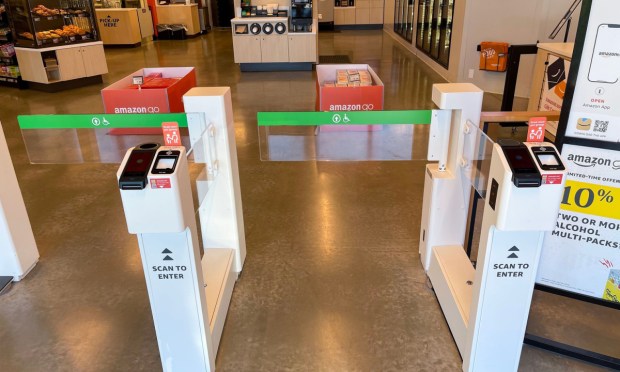From universities to hospitals, campuses with their own identity verification systems are using computer vision checkout to integrate payments more seamlessly into shoppers’ on-site routines.
Earlier this month, for instance, Amazon rolled out badge pay for its Just Walk Out checkout system, enabling doctors, nurses and other healthcare staff to pay for purchases at in-hospital stores with their badges, a capability that launched at Saint Joseph’s/Candler’s Candler Hospital Campus in Savannah, Georgia. The feature links employees’ badges to their payroll deduct account, freeing medical staff from having to think about, say, carrying their wallets or phones during working hours.
Last year, Grubhub launched an integration with Just Walk Out to bring the technology to colleges and universities, enabling students to pay with their meal plans, beginning with Loyola University Maryland.
“One of the things that we were trying to overcome was the ability to offer students snack and sundry type items for longer hours in the day,” Mike Mansfield, the university’s associate vice president of auxiliary operations, said in an interview with PYMNTS at the time. “So, we had a store in that facility that was open five days a week for about six hours a day, and now we’re able to have it open seven days a week, 20 hours a day.”
The move shows a concerted effort to make the payment process invisible, removing credit cards and mobile wallets from the experience and enabling consumers to pay with other kinds of identification. It seems likely that other such spaces could follow — say, for instance, the music festivals where food payments are made via wristband, or hotels, where room keys could enable guests to charge purchases to their tabs.
About a third of all consumers are interested in this kind of payment method, according to the PYMNTS Intelligence study “How We Will Pay Report: How Connected Devices Enable Multitasking Among Digital-First Consumers,” which drew from a survey of more than 4,600 U.S. consumers.
The results revealed that among the 95% of respondents who use connected devices, 35% would be interested in an experience in which they walk into a store and pick up a product, then walk out without standing in a checkout line to pay, with sensors detecting what they have put in their carts, automatically charging them for those items using an app with the payment method. Additionally, 6% reported that they already use this checkout method.
Overall, consumers are open to self-checkout options. Research highlighted in PYMNTS’ “Digital-First Banking Tracker® Series Report” revealed that 84% of consumers in the United States said they enjoy using self-service kiosks, and two-thirds of individuals said they favor self-service models over staffed checkout lanes.
Retailers, too, feel the pressure to offer such options. PYMNTS Intelligence’s study “Big Retail’s Innovation Mandate: Convenience and Personalization,” which drew from a survey of 300 retailers across the U.S. and the United Kingdom, revealed that 60% of grocers think consumers would be very or extremely likely to switch merchants if not offered self-service kiosks.
The adoption of artificial intelligence-powered checkout systems on campuses is revolutionizing the payment experience for consumers on site. The success of this technology in healthcare and university settings indicates its potential for wider adoption in various industries.

Alex Mitchell is your go-to expert for all things mobile. With a passion for the latest smartphones, apps, and mobile innovations, Alex provides in-depth reviews, insightful analyses, and breaking news about the ever-evolving world of mobile technology. Stay connected with Alex to navigate the fast-paced realm of mobile devices.


